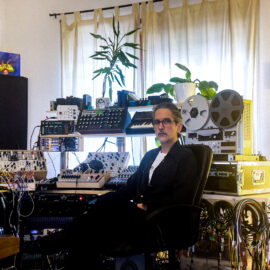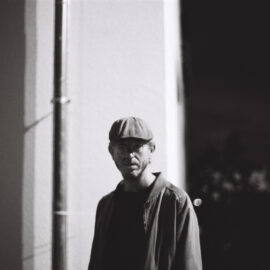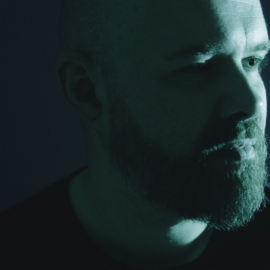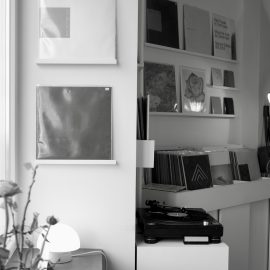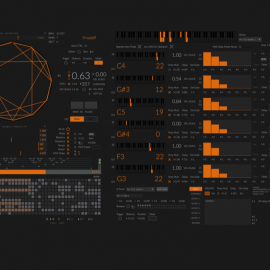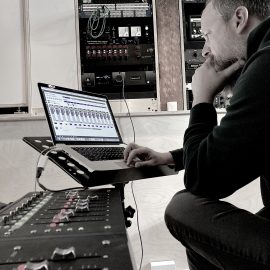Hi Alessandro. We last spoke at the end of 2019. How are you holding up this past year?
Aside from what everyone has gone through, we were in Berlin and we decided to move to Portugal. So it was a night and day change in the sense that we went from the grey, brutalism of a city like Berlin, which has its charm, to the countryside, sheep, and warmth of Portugal. We realized it’s more up our alley. It feels like home. We’re very happy about that.
The year itself was challenging, like it was for everyone, losing all of the shows and having to reinvent ourselves in one way or another. I was lucky because the child in me that gets bored always led me to having a few things going on: whether it’s Bandcamp, collaborations, or designing synthesizers as I did with Tony from Make Noise.
Also, there was my father’s passing which was sudden but also came to a point where he had been an alcoholic for years. So it almost came as a relief in a certain aspect. As you can imagine, it’s something that definitely marked the year in a very strong way. After that, we moved and I was able to digest everything that involved those two months when I was in Italy taking care of family.
Now I can not go crazy. No drinking, no drugs, no smoking. I feel like I can process things in a healthy way.
Obviously, I’ve been preparing a new record which has been more of a Franciscan effort as opposed to an active writing effort. Just like for VOLUME MASSIMO, a lot of it was previous works I had recorded for myself to feel good and I like the therapeutic process of making music. The collection of it was more about archival analysis of things I’ve done and what fits together as a bigger picture.
How much is SCURO CHIARO a continuation of VOLUME MASSIMO, and how much do you think it’s a standalone work?
Half and half. From a creative point of view, it was sparked by VOLUME MASSIMO. Some of the pieces, I can tell you “LO SPECCHIO” and “CHIAROSCURO,” were part of the pool of pieces that I had at the time I compiled VOLUME MASSIMO.
Just like you wouldn’t put cream on the top of a dish of spaghetti aglio e olio – not because the cream is bad, it just doesn’t fit – the same thing happened with these tracks and VOLUME MASSIMO. When I compiled VOLUME MASSIMO, the pieces on that record made it what it is. It made sense. I don’t know why. It tasted good, it sounded good. I still had these two main ingredients that were very important – “CHIAROSCURO” and “LO SPECCHIO” – so that was the beginning of the collection period for what became SCURO CHIARO.
But SCURO CHIARO on its own works just as well. It’s not necessarily volume one and volume two. I don’t want to compare, but it’s not like the Forse series which is just the same sessions divided into three volumes. SCURO CHIARO as an entity on its own is born from parts of what was supposed to be VOLUME MASSIMO.
By all means, it’s none of that B-side bullshit. It has nothing to do with that. I grew up in a world where some of Radiohead’s B-sides were stronger than the record tracks for me. I always hated the concept of B-sides. Why did I have to spend 20 bucks to find a Japanese import for something that is a B-side? It’s not a B-side if I spend more than I spent on the record. So the idea of the B-side is such a misleading thing.
I want to change topics and talk about Strega for a second. How did this partnership with Make Noise come about?
The partnership started way back when I started using Make Noise instruments and modules. Early on I met Tony and Kelly. I became friends with them and we really hit it off. It evolved into a professional collaboration that never came to fruition about 10 years ago. And then Tony designed some things with me in mind for his system that I ended up using live. We always thought about doing something together.
It started as ideas. He asked me, “what would you like in an instrument?” He was always about what I liked about the instruments that allowed me to write full records. It came from a genuine interest in creating an instrument that I felt would be mine, but at the same time was something people could relate to. Obviously, there was a fear of creating something that would be an “Alessandro Cortini” box and people would just sound like me. Or it would be so monotone with the sounds it could make that it wouldn’t be received well. But I think we were lucky in finding people that were very interested in the sounds.
To be honest, we’re compiling an album that will come out in July with artists such as Caterina Barbieri, Hiro Kone, Marta Salogni, Ben Frost, Rob Lowe, and many others. I can tell you they all have the same box and they all sound different. It’s more of a canvas for people to use than something to sound like me or a signature guitar. And that’s why I called it Strega and didn’t put my name on it. I grew up with Steve Vai and Paul Gilbert guitars. While I love these guys, I think it was, personally, being forced to look up to these people and that being the bar instead of figuring out my voice on the instrument. I’m not saying there’s innate negativity in signature instruments. Personally, I felt like it slowed my process of finding my own voice.
Going back to Make Noise, it was a very natural experience. We had a great time and it was three years long from the first sketch to the final product. But I wouldn’t have it any other way and we’re working on something new already. Obviously, it was, “what if this only ends up being for us?” There’s a company behind it and there would be financial consequences. But we’ve been lucky enough that it’s a success. Pre-orders are sold out and we’re very happy that people love it. It led us to think about something else fucked up that people might like!
Tell us a bit about the idea behind this instrument and the areas where we can hear it on the album.
From a practical point of view, the idea behind the instrument was to create an instrument that I could harvest a similar emotional response from the machines I artistically grew up with – like the Music Easel or EMS Synthi – without stealing the elements. A lot of times you see people obsessing over specific elements of a machine like the Moog filter. Most of the time, it’s not that element that makes the machine special. The element shines because it is surrounded by a specific architecture and a specific series of ingredients that makes that instrument – how the knobs feel, the color, the tactile feedback. And that’s what we were shooting for, not necessarily the single ingredients or elements of the instruments I loved making music with. It was more what those ingredients made me feel like. How can I recreate that emotion? That’s why you won’t find elements that you find on the Synthi or the Easel. To me, the result is the same, emotionally.
I’ve had the prototype for a year and a half, probably longer. I’ve had the chance to use it on several pieces. Off the top of my head, I’ve used it on “LO SPECCHIO,” “CHIAROSCURO,” and “VERDE.”
I can tell you the weird emotion of receiving something you designed and then it’s such a multidimensional version of releasing a record. Once you release a record, and even though it’s instrumental, people have a much stronger emotional partnership with the listener because the listener can be more emotionally involved. There is no lyrical content. They can make it about whatever they want.
With a musical instrument, there’s your imprint, but there will also be their outcome and creative output. It’s a weird, exponentially euphoric feeling when I get tagged on Instagram by people making music with something we designed. It was so personal. I can’t tell you how lucky I feel about all of it. The Italian in me would tell you something bad is about to happen because this is so good. Well, the Catholic in me. I’m not Catholic, but I was brought up Catholic.
Besides your very own module, have you used any other new toys or techniques on the album?
More guitar. I kept the thread that I initiated with VOLUME MASSIMO in bringing back the guitar. Guitar has always been a delicate thing for me. I started as a guitar player in a specific scene – the hard rock, shredding scene – and I loved that as a kid. I still love certain things about it. But it’s a little bit like oil and water when it comes to what I became and what I like doing.
What I do with synthesizers, I can’t do with guitars for the simple reason that when I look at a guitar, I think of a specific way of playing the guitar. So it’s a very delicate and slow process to peel off the tape. You know how with peeling labels you have to be super slow because otherwise, you leave the tape on the box? It’s the same thing. I can’t force myself by saying, “alright, the guitar now, strings all tuned differently…” It doesn’t work that way. It’s something I’ve been doing for so long and I’m trying to strip it away.
I love shredding and technique. I love players that are expressive. I love Frank Zappa, Steve Vai, Joe Satriani, Jeff Beck. There are a lot of guitar players that I love. But I know there’s still, hidden somewhere, a way of tapping guitar for me. No pun intended. I love Van Halen. He’s number one. Tapping the guitar as a creative instrument where it will feel at home in what I do.
In SCURO CHIARO, I’m continuing that process by using a little more guitar and using it in a way that you can’t tell if it’s one of my synths or if it’s a guitar.
